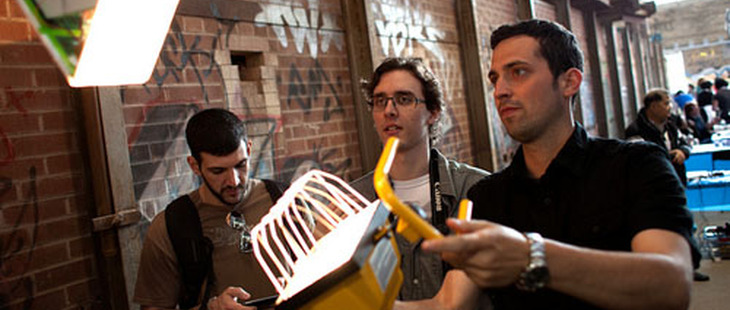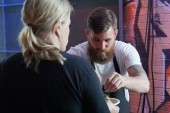
(Mun Wai Chau/Treehouse Group) The man in the black-rimmed specs flips the switch on a white frame holding a brass statue. After some coaxing, (“its battery power’s running low…”) an inner frame extends, flips on its axis to reveal a blue painting before settling back into place. Of course: the revolving two-sided art socket, perfect for the engineer who has too much art and not enough wall space. An ingenious solution for something that was never a problem. And that might just be the point. Alan Majer is an inventor (or as his card reads “Mad Scientist at Large”) showing off his stuff at the Mini Maker Faire, held in early May at the Evergreen Brick Works in the Don Valley. The weekend attracts high school students, hackers and hobbyists, who all come to share secrets and show off their latest creations. The Brick Works are a fitting venue; with girders jutting at odd angles above, aisles of brick ovens, splashes of graffiti below, it’s like some kind of post-apocalyptic market. One of those good ones, where they’re rebuilding society. Its name comes from Make magazine, a California-based publication that focuses on DIY projects for the internet age. Bringing it to the Brick Works is the Treehouse Group, a local collective of science-minded citizens, with ties to the MaRS discovery centre. What makes it “Mini” is their licensing of the brand. Treehouse’s eventual goal is to attract one of the full-sized fairs that Make organizes itself, such as the one in San Francisco that drew 80,000 people over its two-days. Maker culture lies at the intersection of art and science. The bead designer using a custom made blowtorch to melt her glass. The dude strumming an electric guitar with green lasers instead of strings, the instrument warbling like a rock ‘n roll Theremin. One of the most astonishing displays at the Mini-Faire is a collection of handmade wooden telescopes, carved in blonde and amber, with the smiling face of the man and the moon on the side. But it’s about more than clever design; they’re perfectly functional. Normand Fullum, their creator, hand grinds each mirror that collects the light inside. The principle, he explains, is the same used by Isaac Newton back in the 1660s and is no less effective today: peek into the viewfinder and you can read the serial numbers stamped onto the girders high up on the ceiling. It’s not just scientists – maker culture is a big tent that also pulls in crafters, artisans, single-batch cookie bakers. But it’s definitely science’s show today, a celebration of all that is tactile in a time of Twitter – and quite literally in the case of one exhibit, an ancient typewriter that is rigged to transmit in 140 characters. Then there’s Aesthetic, a bad-ass trio of engineers, who show off solar-activated rope crawlers and canvases that let you “paint” with light, prototypes for an interactive exhibit they’re assembling for a Calgary science museum. Light rope walker, Aesthetic Studio (Andrew Williamson) Supporting the scene are incubators of Made culture, like Queen St. West institution Active Surplus, always happy to supply would-be inventors with a couple of gears or a bucket of baby legs. And collaborative workshops like InterAccess, HackLab and Site 3 – all of which have been inviting people to try their hand at soldering, programming and modifying all manner of machine. One of the notable things about the Faire is just how accessible it makes science and the idea of innovation. You see it all around you, whether it’s making a remote control train you can pilot with your iphone, or plastic objects fashioned on a 3-D printer like the makerbot. Each table had something that reconnected you with the idea of how simple discovery can be. I went to the Maker Mini-Faire because I have an interest in Made culture. I’ve been writing and producing the Made In Toronto video series here at the Standard. We were curious about this fascination that the web seems to have, in places like Boing Boing, with what should be its opposite: those who grapple with “things” in real life. Over the last month we’ve spoken to a butcher, a baker, and a candlestick maker (all right that last one is sort of a steampunk lighting designer, but close enough). It’s easy to idolize anyone who makes things with their hands these days, especially if you spend your time sitting under fluorescent lights staring at a computer. There’s a longing for a life unplugged, using your own sweat and the tools of your trade. But that way lies nostalgia, a valuing of the past for past’s sake, a sort of snobbery for only the most expensive handcrafted goods. What’s better is that whatever you’re doing, you’re doing it for its own sake, whether it’s the perfect wooden telescope or a two-sided art socket. And in that fashion, maker culture is here to remind us that our own creativity is just waiting to be found.














